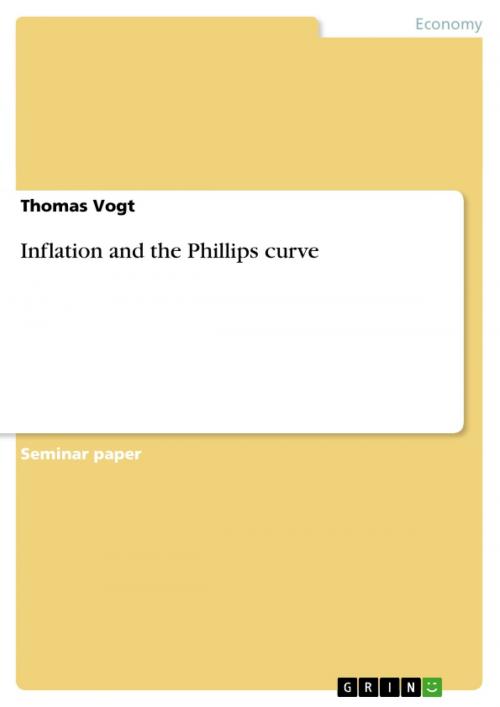| Author: | Thomas Vogt | ISBN: | 9783638059831 |
| Publisher: | GRIN Publishing | Publication: | June 9, 2008 |
| Imprint: | GRIN Publishing | Language: | English |
| Author: | Thomas Vogt |
| ISBN: | 9783638059831 |
| Publisher: | GRIN Publishing |
| Publication: | June 9, 2008 |
| Imprint: | GRIN Publishing |
| Language: | English |
Seminar paper from the year 2007 in the subject Economics - Economic Cycle and Growth, grade: 1,0, University of applied sciences Frankfurt a. M., course: Inflation and the Phillips Curve, 16 entries in the bibliography, language: English, abstract: In this paper the author will discuss the relation of inflation and the Phillips curve. First, the concept and the different forms of inflation and their economical reasons will be explained. Afterwards the three prevalent models of the Phillips curve in literature are introduced and explained. The author will look into the theory of the NRU and NAIRU and how they relate to the concept of the Phillips curve. In the last part of the paper, the applicability and validity of the Phillips curve for Germany is investigated more closely and the characteristics of the Phillips curve for Germany will be described. The Phillips curve originates of an empirical study of Arthur W. Phillips in 1958. There he describes the existence of a negative relationship between the rate of unemployment and the nominal wage growth in the UK between the years 1861-1957. The curve shows, that the higher the rate of unemployment, the lower the rate of wage inflation. His work represented a milestone in the development of macroeconomics. Especially in the sixties and seventies, politicians in the USA and Europe thought they can interpret the relation of inflation and unemployment as a menu card of fiscal and monetary policy. A well-known quote by Helmut Schmidt, former chancellor of Germany in the 1970s, supports this thinking, when he said that an inflation rate of five percent is better than a five percent rate of unemployment. In the following years, a lot of different economist (Keynes, Samuelson, Friedman, Phelps, Lipsey et al.) modified the original curve and supported it with their customized theories. In this paper the author will discuss the relation of inflation and the Phillips curve. First, the concept and the different forms of inflation and their economical reasons will be explained. Afterwards the three prevalent models of the Phillips curve in literature are introduced and explained. The author will look into the theory of the NRU and NAIRU and how they relate to the concept of the Phillips curve. In the last part of the paper, the applicability and validity of the Phillips curve for Germany is investigated more closely and the characteristics of the Phillips curve for Germany will be described.
Seminar paper from the year 2007 in the subject Economics - Economic Cycle and Growth, grade: 1,0, University of applied sciences Frankfurt a. M., course: Inflation and the Phillips Curve, 16 entries in the bibliography, language: English, abstract: In this paper the author will discuss the relation of inflation and the Phillips curve. First, the concept and the different forms of inflation and their economical reasons will be explained. Afterwards the three prevalent models of the Phillips curve in literature are introduced and explained. The author will look into the theory of the NRU and NAIRU and how they relate to the concept of the Phillips curve. In the last part of the paper, the applicability and validity of the Phillips curve for Germany is investigated more closely and the characteristics of the Phillips curve for Germany will be described. The Phillips curve originates of an empirical study of Arthur W. Phillips in 1958. There he describes the existence of a negative relationship between the rate of unemployment and the nominal wage growth in the UK between the years 1861-1957. The curve shows, that the higher the rate of unemployment, the lower the rate of wage inflation. His work represented a milestone in the development of macroeconomics. Especially in the sixties and seventies, politicians in the USA and Europe thought they can interpret the relation of inflation and unemployment as a menu card of fiscal and monetary policy. A well-known quote by Helmut Schmidt, former chancellor of Germany in the 1970s, supports this thinking, when he said that an inflation rate of five percent is better than a five percent rate of unemployment. In the following years, a lot of different economist (Keynes, Samuelson, Friedman, Phelps, Lipsey et al.) modified the original curve and supported it with their customized theories. In this paper the author will discuss the relation of inflation and the Phillips curve. First, the concept and the different forms of inflation and their economical reasons will be explained. Afterwards the three prevalent models of the Phillips curve in literature are introduced and explained. The author will look into the theory of the NRU and NAIRU and how they relate to the concept of the Phillips curve. In the last part of the paper, the applicability and validity of the Phillips curve for Germany is investigated more closely and the characteristics of the Phillips curve for Germany will be described.















